Understanding Co-Teaching Models that Work
Effective co-teaching requires clear communication and defined roles
Co-teaching occurs when two educators share responsibility for planning, instructing, and evaluating students in a classroom. Unlike traditional teaching models where a single teacher leads instruction, co-teaching leverages the strengths of multiple educators to meet diverse student needs. When implemented correctly, these Models that Work create inclusive environments where all students can thrive.
Successful co-teaching requires specific teacher skills including effective communication, flexibility, and willingness to share responsibility. According to a 2019 study published in the International Journal of Inclusive Education, teachers who receive proper training in co-teaching methodologies report higher satisfaction rates and better student outcomes.
Before diving into specific models, it’s important to understand that effective co-teaching isn’t about dividing a class in half or taking turns teaching. Rather, it’s about creating a seamless educational experience where both teachers’ expertise is fully utilized. Let’s explore six proven co-teaching approaches that have demonstrated success in K12 classrooms across the United States.
Model 1: One Teach, One Observe – A Foundational Approach that Works

How It Works
In the One Teach, One Observe model, one teacher takes the lead instructional role while the other gathers specific data about students. This approach allows for systematic observation of student behavior, participation, and understanding that might otherwise go unnoticed in a busy classroom.
The observing teacher might track:
- Student engagement levels
- Participation patterns
- Specific student behaviors
- Response to instructional strategies
- Areas where students struggle
Teacher Skills Required
This model requires specific teacher skills including systematic observation techniques, data collection methods, and the ability to analyze information objectively. The lead teacher must be comfortable with being observed while maintaining engaging instruction.
Implementation Tips
To implement this model effectively:
- Decide in advance what specific data to collect
- Create simple observation forms
- Set aside time to discuss observations after class
- Switch roles regularly so both teachers have observation opportunities
- Use observations to inform future lesson planning
While this model might seem basic, it provides valuable insights that can enhance professional development and improve instructional practices. The key is using the gathered data meaningfully to adjust teaching strategies.
Model 2: One Teach, One Assist – Supportive Models that Work
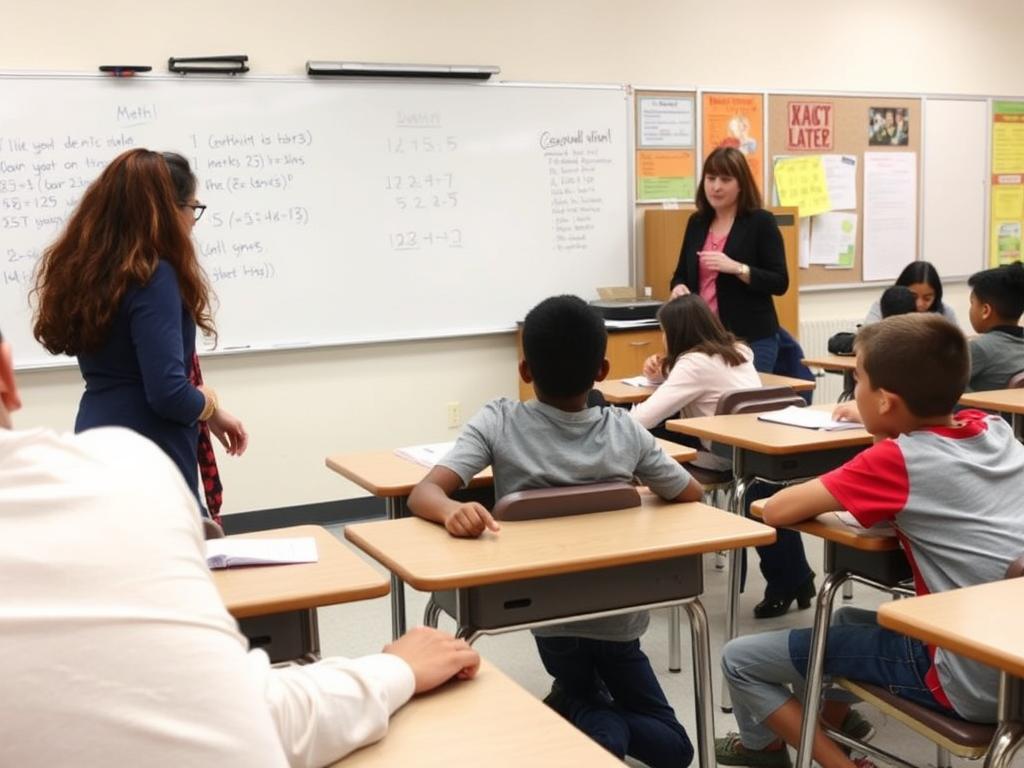
How It Works
In this approach, one teacher takes primary responsibility for delivering instruction to the whole class, while the other circulates and provides individual assistance to students as needed. This model allows for immediate intervention when students struggle, without interrupting the flow of the lesson.
The assisting teacher might:
- Clarify directions for confused students
- Provide additional examples
- Redirect off-task behavior
- Adapt materials for students with special needs
- Collect informal assessment data
Teacher Skills Required
Effective implementation requires teacher skills in differentiation, quick problem-solving, and the ability to provide support without creating dependency. Both teachers must communicate nonverbally during the lesson to coordinate their efforts.
Implementation Tips
For successful implementation:
- Establish clear signals between teachers
- Rotate roles regularly to maintain parity
- Ensure the assisting teacher has access to all necessary materials
- Avoid having the same teacher always in the supporting role
- Debrief after lessons to discuss student needs identified
Enhance Your Co-Teaching Skills
Looking to improve your implementation of these co-teaching models? Our specialized professional development courses can help you master the teacher skills needed for effective collaboration.
Model 3: Parallel Teaching – Instructional Models that Work

How It Works
Parallel teaching involves dividing the class into two heterogeneous groups, with each teacher instructing one group. Both teachers cover the same content but may use different approaches or examples. This model significantly reduces the student-teacher ratio, allowing for more interaction and participation.
Benefits of parallel teaching include:
- Increased opportunities for student participation
- More individualized attention
- Reduced behavior issues due to smaller groups
- Ability to tailor explanations to group needs
- Enhanced monitoring of student understanding
Teacher Skills Required
This model demands strong teacher skills in pacing, noise management, and coordinated planning. Both educators must be equally comfortable with the content and be able to cover the same material in roughly the same timeframe.
Implementation Tips
To make parallel teaching effective:
- Plan together to ensure content consistency
- Arrange the classroom to minimize cross-group distractions
- Consider acoustics when setting up group spaces
- Create heterogeneous groups rather than ability grouping
- Establish time checks to keep both groups on pace
Research shows that parallel teaching can be particularly effective for discussion-based lessons, concept introduction, and practice activities. A study in the Journal of Special Education found that students in parallel teaching groups had higher engagement rates compared to whole-class instruction.
Model 4: Station Teaching – Collaborative Models that Work
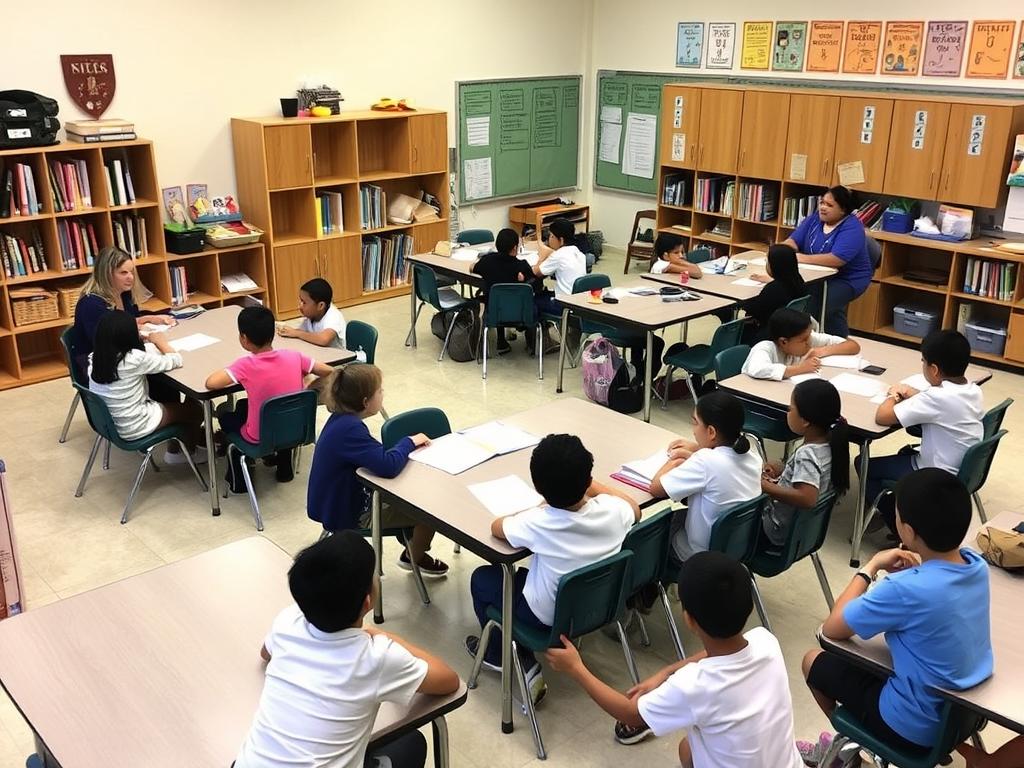
How It Works
Station teaching divides students into groups that rotate through various learning stations. Each teacher takes responsibility for teaching content at one station, while students work independently or collaboratively at other stations. This approach allows for targeted instruction in small groups while maximizing learning time.
A typical station teaching setup might include:
- Teacher A leading direct instruction at one station
- Teacher B facilitating guided practice at another station
- An independent work station
- A technology-based learning station
- A collaborative problem-solving station
Teacher Skills Required
Successful station teaching requires teacher skills in classroom management, transition facilitation, and designing meaningful independent activities. Teachers must be adept at pacing instruction to fit station rotation timeframes.
Implementation Tips
For effective station teaching:
- Start with just 2-3 stations and gradually increase
- Create clear visual directions for each station
- Practice transitions before implementing content
- Use timers to manage rotation schedules
- Ensure independent stations have self-checking components
Station teaching is particularly valuable for differentiating instruction and addressing various learning styles. It allows teachers to leverage their individual strengths while providing students with varied learning experiences.
Looking to enhance your teacher skills in station management? Professional development focused on co-teaching can provide strategies for creating engaging, effective learning stations.
Model 5: Alternative Teaching – Differentiation Models that Work
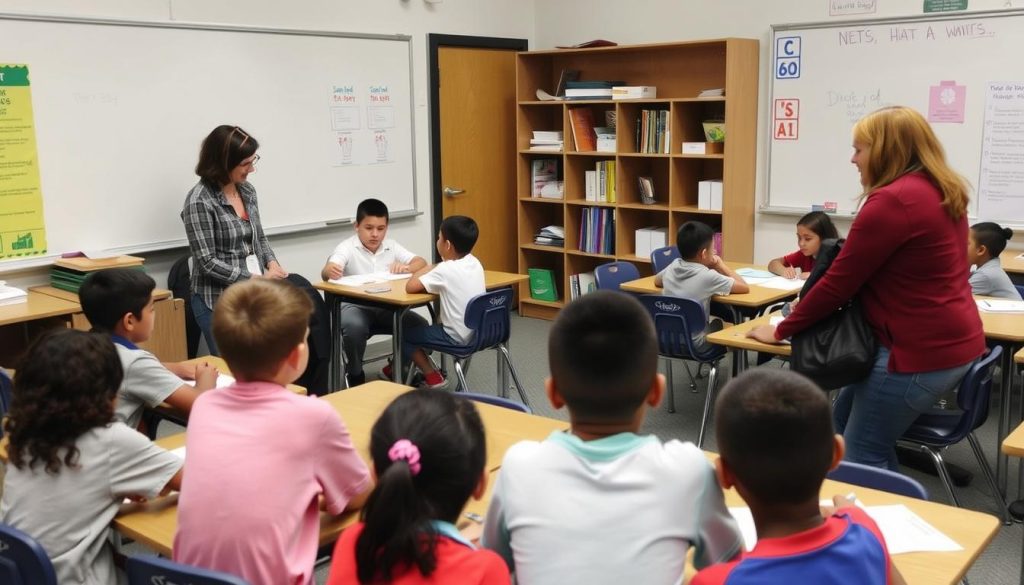
How It Works
Alternative teaching involves one teacher working with a small group of students while the other instructs the larger group. This model is ideal for pre-teaching concepts, providing remediation, offering enrichment, or conducting assessments with select students.
Common applications include:
- Pre-teaching vocabulary or concepts
- Reteaching content to struggling learners
- Providing enrichment for advanced students
- Conducting reading groups
- Administering assessments to specific students
Teacher Skills Required
This approach requires teacher skills in identifying student needs, designing targeted interventions, and managing multiple learning activities simultaneously. Both teachers must be comfortable with flexible grouping practices.
Implementation Tips
To implement alternative teaching effectively:
- Vary group composition to avoid stigmatizing students
- Create a designated space for small group work
- Keep small group sessions focused and time-bound
- Ensure both teachers take turns leading small groups
- Connect small group work to whole class learning
When used thoughtfully, alternative teaching can address learning gaps while maintaining inclusive practices. The key is ensuring that all students have access to both teachers over time, rather than creating a permanent division.
Model 6: Team Teaching – Integrated Models that Work

How It Works
Team teaching, sometimes called “teaming,” occurs when both teachers share instruction of all students. They may take turns leading discussions, demonstrating concepts, or explaining content. This fluid approach creates a dynamic learning environment where teachers build on each other’s ideas and strengths.
In effective team teaching:
- Teachers alternate between leading and supporting roles
- Instruction flows naturally between educators
- Teachers may interject with clarifying points or examples
- Different perspectives on content are presented
- Teachers model academic discourse and collaboration
Teacher Skills Required
This model demands advanced teacher skills including strong interpersonal communication, content mastery, and the ability to improvise. Teachers must be comfortable sharing the spotlight and building on each other’s contributions.
Implementation Tips
For successful team teaching:
- Plan lessons together in detail
- Establish verbal and nonverbal cues
- Practice the flow of instruction before class
- Leverage each teacher’s unique expertise
- Debrief regularly to refine the approach
Team teaching represents the most integrated form of co-teaching and often develops after partners have established trust and rapport. While challenging to master, it can create powerful learning experiences for students who benefit from seeing collaboration in action.
Choosing the Right Co-Teaching Model for Your Classroom
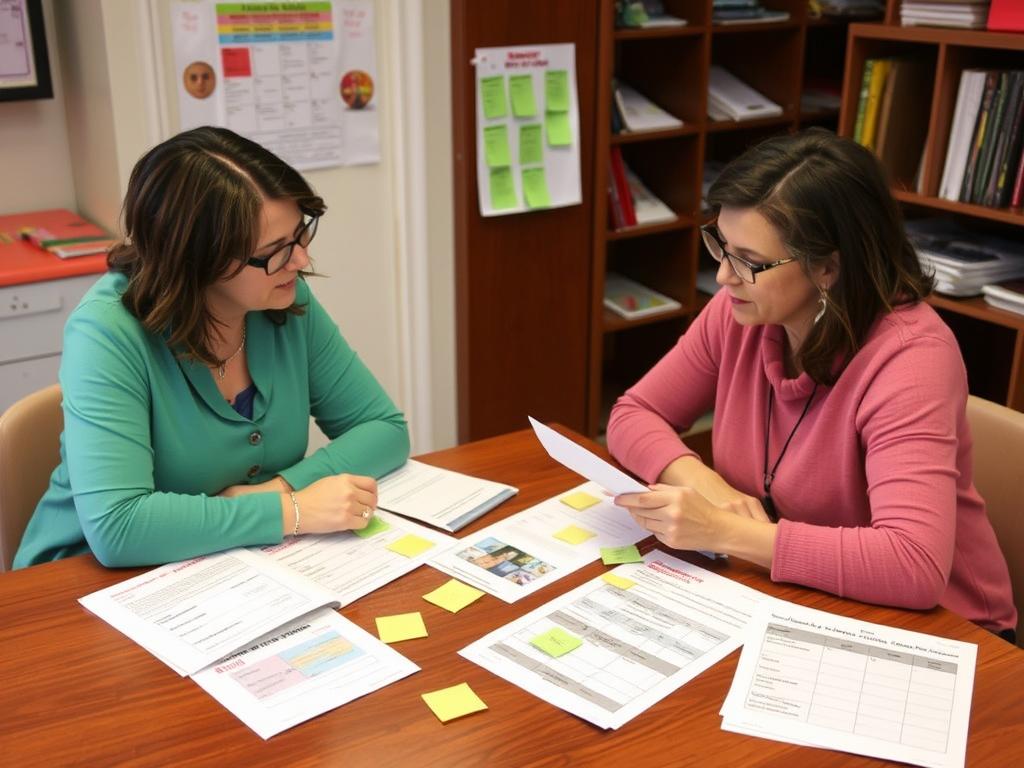
Selecting the appropriate co-teaching model depends on various factors including lesson objectives, student needs, teacher expertise, and available resources. Effective co-teachers typically use a combination of models, sometimes switching between several approaches within a single lesson.
Factors to Consider When Selecting a Model
When Choosing a Model, Consider:
- Learning objectives for the lesson
- Student needs and learning profiles
- Content complexity and structure
- Physical classroom space and layout
- Available resources and materials
- Teacher strengths and expertise
- Time constraints and pacing needs
Common Pitfalls to Avoid:
- Overusing one model exclusively
- Assigning the same teacher to the same role
- Separating students by ability permanently
- Failing to plan collaboratively
- Underutilizing the expertise of either teacher
- Creating parallel but disconnected lessons
- Neglecting to evaluate model effectiveness
Matching Models to Instructional Goals
| Co-Teaching Model | Best For | Example Scenario |
| One Teach, One Observe | Gathering data on student performance or behavior | Identifying participation patterns during class discussions |
| One Teach, One Assist | New content introduction with support for struggling learners | Teaching a complex math concept while providing individual help |
| Parallel Teaching | Discussion-based lessons or practice activities | Conducting a literature circle with smaller groups |
| Station Teaching | Multiple skill practice or content exploration | Science lab with different experiment stations |
| Alternative Teaching | Pre-teaching, re-teaching, or enrichment | Working with struggling readers on vocabulary before a lesson |
| Team Teaching | Integrated content presentation or modeling discourse | Demonstrating a debate or presenting multiple perspectives |
Developing the teacher skills to select and implement the right model at the right time takes practice and reflection. Professional development in co-teaching strategies can help educators make these decisions more effectively.
Overcoming Common Co-Teaching Challenges
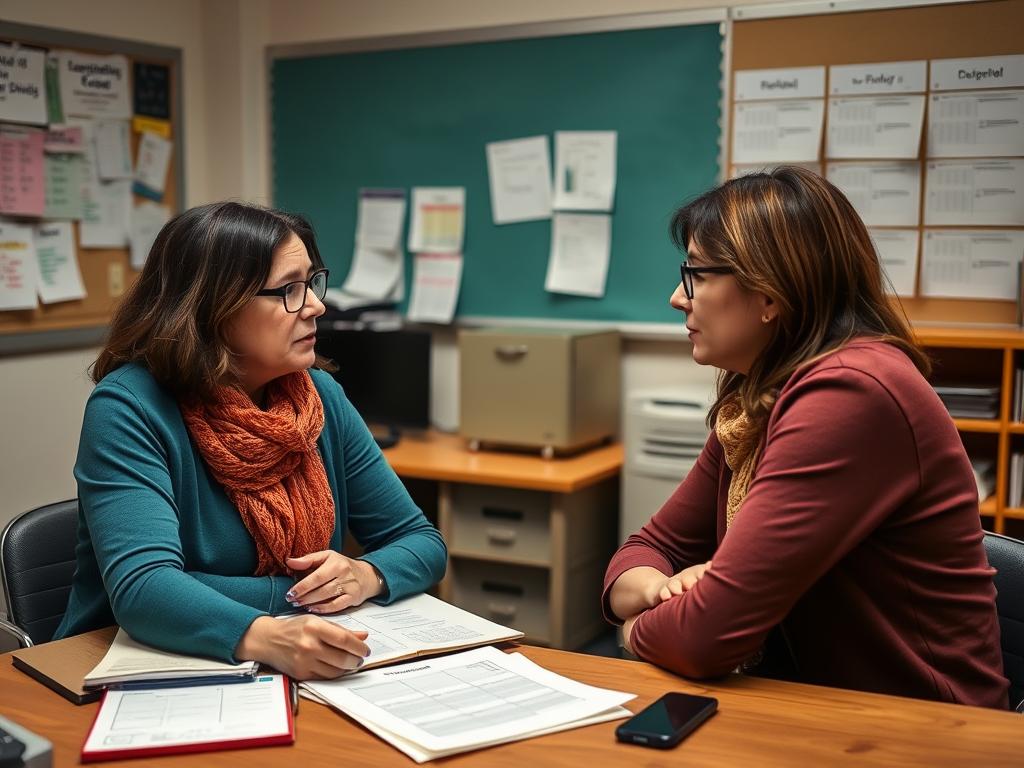
Even the most effective co-teaching Models that Work can face implementation challenges. Recognizing and addressing these obstacles proactively can help teaching partnerships thrive.
Common Challenges and Solutions
Planning Time Constraints
Finding adequate time to plan together is consistently cited as the biggest challenge for co-teachers.
Solutions:
- Request common planning periods during scheduling
- Use digital tools for asynchronous planning
- Develop planning templates to streamline the process
- Schedule regular weekly planning meetings, even if brief
- Create unit plans together, then divide daily planning responsibilities
Role Parity and Equity
When one teacher (often the special educator) is relegated to a permanent assistant role, the partnership suffers.
Solutions:
- Establish clear, equitable roles from the beginning
- Rotate leadership responsibilities regularly
- Leverage each teacher’s unique expertise
- Ensure both names appear on classroom materials
- Present a unified front to students and parents
Philosophical Differences
Differences in teaching philosophy, classroom management, or grading practices can create tension.
Solutions:
- Discuss teaching beliefs and preferences openly
- Establish shared classroom expectations
- Compromise on areas of disagreement
- Focus on student outcomes rather than personal preferences
- View differences as opportunities to learn from each other
Administrative Support
Lack of administrative understanding or support can undermine co-teaching efforts.
Solutions:
- Educate administrators about co-teaching benefits and needs
- Invite administrators to observe successful co-taught lessons
- Share student success data from co-taught classes
- Request specific supports like common planning time
- Seek professional development opportunities together
Developing advanced teacher skills in communication, conflict resolution, and collaboration can help address these challenges. Many educators find that ongoing professional development specifically focused on co-teaching partnerships provides valuable strategies for overcoming obstacles.
Measuring the Success of Your Co-Teaching Models
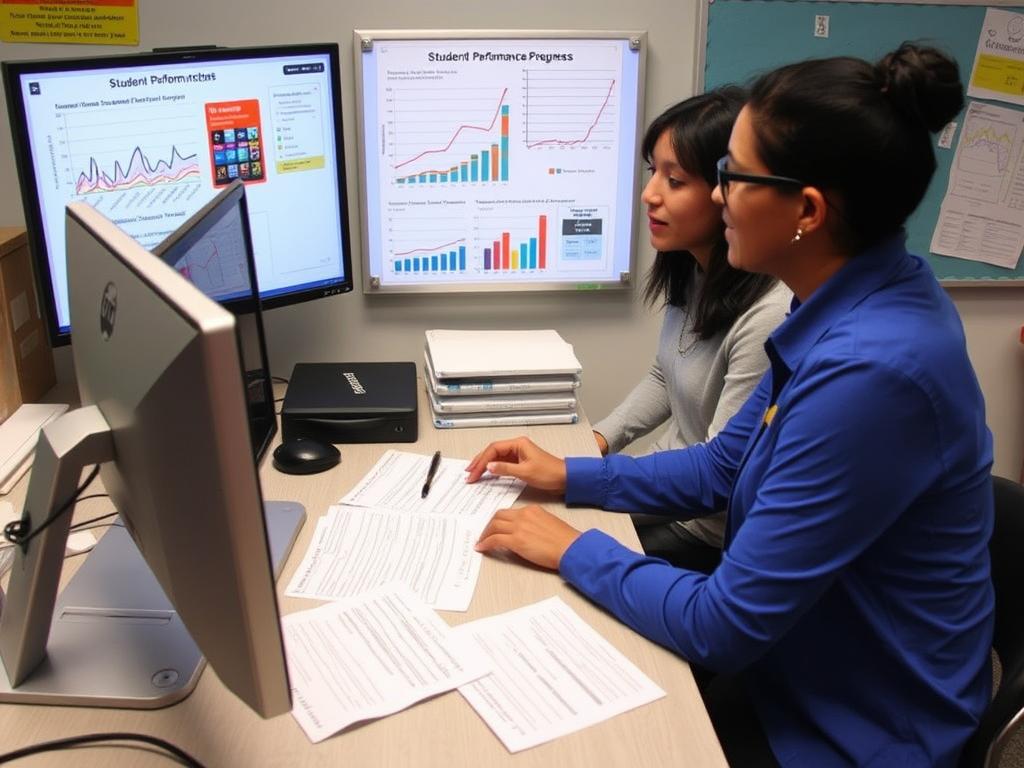
How do you know if your co-teaching Models that Work are actually working? Establishing clear metrics for success helps partners evaluate their effectiveness and make necessary adjustments.
Indicators of Effective Co-Teaching
Look for these signs that your co-teaching partnership is successful:
Student-Centered Indicators
- Improved academic performance
- Increased student engagement
- Higher completion rates for assignments
- More positive student attitudes toward learning
- Reduced behavior issues
- Greater participation from all students
Teacher-Centered Indicators
- Balanced teacher roles and responsibilities
- Smooth transitions between instructional approaches
- Efficient use of instructional time
- Shared ownership of all students
- Complementary use of teacher skills and expertise
- Mutual professional growth and learning
Data Collection Strategies
Gathering both quantitative and qualitative data helps provide a complete picture of co-teaching effectiveness:
- Student achievement data (test scores, project results)
- Student engagement metrics (participation rates, time on task)
- Student feedback surveys or interviews
- Peer observations with specific co-teaching look-fors
- Self-assessment using co-teaching rubrics
- Video analysis of co-taught lessons
Regular reflection on these indicators helps co-teachers refine their practice and maximize the benefits of their partnership. Many successful co-teachers schedule quarterly evaluation meetings to review data and set goals for improvement.
Professional Development for Co-Teaching Excellence
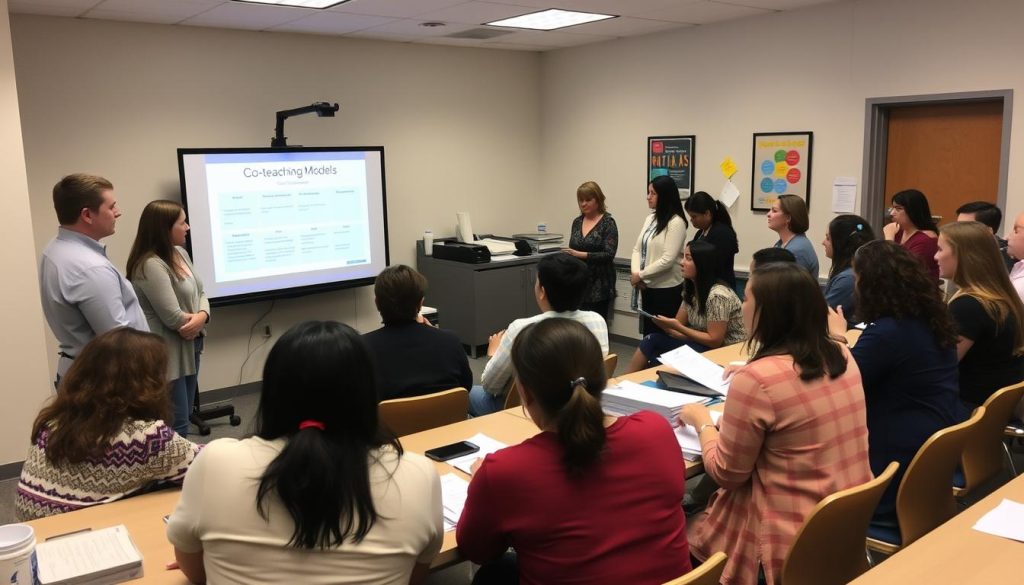
Developing the teacher skills necessary for effective co-teaching requires ongoing professional growth. Even experienced educators benefit from continued learning about co-teaching best practices.
Essential Professional Development Areas
To enhance your co-teaching effectiveness, seek professional development in these key areas:
- Co-planning strategies and templates
- Role negotiation and parity
- Differentiation techniques for diverse learners
- Formative assessment in co-taught settings
- Conflict resolution for teaching partnerships
- Advanced implementation of specific co-teaching models
According to research by Scruggs and Mastropieri, teachers who receive ongoing professional development in co-teaching report higher levels of confidence and effectiveness compared to those who receive only initial training.
Take Your Co-Teaching to the Next Level
Ready to enhance your teacher skills and master these co-teaching Models that Work? Our comprehensive professional development program provides practical strategies, implementation tools, and ongoing support.
Conclusion: Building Successful Co-Teaching Partnerships
The six co-teaching Models that Work presented in this guide offer powerful frameworks for collaboration that benefits both students and teachers. From One Teach, One Observe to Team Teaching, each model provides unique opportunities to leverage the strengths of both educators while addressing diverse student needs.
Effective co-teaching doesn’t happen by accident—it requires intentional planning, clear communication, and ongoing refinement of teacher skills. By thoughtfully selecting and implementing these models, co-teachers can create inclusive learning environments where all students have opportunities to succeed.
Remember that co-teaching is a journey, not a destination. The most successful partnerships evolve over time as teachers build trust, develop shared understanding, and continuously improve their collaborative practice. With commitment and the right support, co-teaching can transform not only student learning but also teacher professional growth.
Which co-teaching model will you try first? How might you combine different models to meet the needs of your students? The possibilities are endless when two dedicated educators join forces to create powerful learning experiences.




